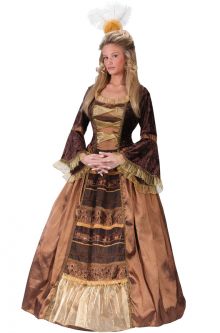The middle and lower classes were banned from wearing certain fabrics that were rarer like silk lace fur velvet and such. During the Renaissance period there were Sumptuary Laws meaning that there were rules that dictated what types of clothing fabrics and even colors that certain classes could wear.

39 Best Renaissance Women Lower Class Ideas Historical Clothing Historical Fashion Renaissance Costume
Nuns wore habits and wimples the color indicating their habitat.

. Read customer reviews find best sellers. Fashion was a big status symbol during the Renaissance. Matrons would wear veils over their hair and widows wore hooded veils.
Brown for the Franciscans and black and white for the Dominicans. Lower-Class Dress Fashion and Identity in Europe 14501650 Renaissance Society of America Annual Meeting 17-19 March 2019 Toronto In recent years there has been a surge in interest in Renaissance and Early Modern dress especially in the context of European courts and wealthy households. They wore uncomplicated flat caps that were made of wool felt or leather.
Then they started to dress like adults. First there was the basic shirt and depending on your economic class it would be made with expensive silk or cheap linen. It had a huge impact on the history of Europe.
Women of the lower classes wore much less restrictive styles both for freedom of movement and because they did not have servants to help them dress. Mens renaissance clothing although simpler than womens dresses still had layers. The children were considered as young adults and were dressed similarly to their parents.
The word Renaissance is a French word which means rebirth. RENAISSANCE Renaissance was a historical era and a cultural movement in Europe that took place between the 14th and 17th century. The lower class also called the Peasant class were made to wear off-white clothes instead of white.
Renaissance Style for Men. Their shirts were made out of flannel and other cheap materials. A lower-class woman might wear a padded roll for fashion as well as convenience.
How to get repeat customers. The people wore aprons fitted sleeves and partlets or neckclothes. Both boys and girls through their toddlerhood till the age of 3 to 5 wore biggins hat and a shift.
Also the upper class or nobility were able to wear richer colors. Peasant were the poorest class so they couldnt afford elaborate articles of clothing or expensive fabrics. In dressing a lower class women would wear a much looser corset or none at all and would possibly eschew other underpinnings such as bum rolls crescent-shaped cushions worn around the hips or farthingales hoop.
The wheel farthingale produced the exaggerated huge skirt pictured below. Daily Life Lower class women and girls during the Renaissance lived in a completely different world compared to those who had higher status. May 14 2020 - Explore Margrit Colliers board Renaissance Women Lower Class on Pinterest.
Oct 5 2015 - renaissance clothing lower class - Google Search. Women wore Pianelle on their feet which were shoes that are much like todays open-toed mules or platform sandals. Reds tans dark greens and all shades of brown tended to be popular among the Flemish lower classes according to the paintings done by Aertsen Beuckelaer and Brueghel in Flanders during the 1560s and 1570s.
The lower-class men dressed for utility and wore only hoses and shirts. In similarity of differences the upper class had many more options in the amount of clothing they could own. These artists also show black as a main color of lower class costume usually as a partlet.
Petticoats to fill out a gown and keep. The wealthy literally wore their wealth as the elaborate expensive clothing helped authorise an image of wealth for the owner. See more ideas about historical clothing historical fashion renaissance fashion.
Always a good deal. How to schedule fewer meetings and get more done. Clothing of Different Classes by Emily Johnson.
The lower classes materials would be linen wool or sheepskin. Ad Browse discover thousands of brands. They also did not generally wear the restrictive collars preferred by upper-class women and tended to wear simpler head coverings including half-bonnets berets or veils.
On the other hand the upper classes wore materials such as silk velvet brocade and satin. Lower-class women wore less-elaborate dresses in the same silhouette but with fewer layers and less ornamentation. It was the wealthy or ruling class that led the fashion.
Lower Class Peasants servants marketpeople and beggars were the main people in the lower class they did not have money to spend on clothing. Ad Free 2-day Shipping On Millions of Items. Lower-class women were only allowed to wear one color so they would slash their clothing to make the underneath color show through.
Originating in Spain to create a dome-shaped skirt a farthingale held skirt fabric away from the legs and offered ease of movement. Attire All women wore. The lowest class in the Renaissance were the peasants.
This period is regarded as of great importance because it recorded great developments in intellectual. Although revealing of important aspects of identity. A shift loose linen smock worn to protect the gown.
Renaissance Clothing And Sumptaury Laws
Renaissance Clothing And Sumptaury Laws

Renaissance Clothing Lower Class Google Search Renaissance Clothing Renaissance Dress Peasant Renaissance Fashion

Renaissance Attire Guide Pearson S Renaissance Shoppe

How To Dress In Renaissance Fashion Pure Costumes Blog

How Did People Dress In Renaissance England Central Coast Renaissance Festival

Renaissance Period Fashion Clothing And Art Aakriti Malhotra
0 comments
Post a Comment